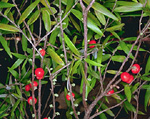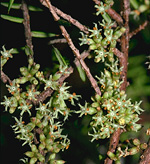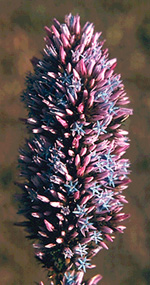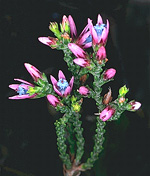 |
The Epacridaceae are a characteristically Australian family, with many species in southern and eastern Australia and only a few genera extending beyond Australia to Malesia, New Zealand and South America. They are most commonly found in dry or damp heathlands on poor, sandy soils, although a few are found in forests or in temperate or high-altitude tropical rain forests. Some species grow in the sub-alps, but none in the central deserts or monsoonal savannahs.
Characteristic features of the family Epacridaceae in Australia include: - shrubs, rarely small trees, often rather spindly and with small, hard, sharply-pointed, leaves which are alternate and often with closely-set parallel venation
- flowers usually small but showy, white, cream, red, pink or green, rarely bluish, more or less tubular to bell- or urn-shaped, and often surrounded at the base by overlapping bracts
- ovary superior and surrounded by a disc or series of nectary glands
- fruit a capsule or drupe, and then often white or brightly coloured when mature
Description
Evergreen trees or shrubs. Vegetative reproduction absent or by root suckers. Stems unarmed but the leaves often with spinescent apices. Internal secretions not obvious. Plants glabrous or with simple, glandular or non-glandular, unicellular hairs. Leaves alternate and spiral, or pseudo-opposite, or rarely whorled or pseudo-whorled, petiolate, subsessile or sessile. Stipules absent. Lamina simple, symmetric, ?filiform, acicular, subulate, linear, lanceolate, ovate, elliptic, oblanceolate or obovate; base cuneate, attenuate or cordate; margins entire, crenate or serrate, ±flat, revolute or recurved; venation parallel, with the midrib conspicuous or inconspicuous, and the tertiary venation not reticulate; surfaces not punctate, leathery. All the flowers bisexual. Inflorescences terminal or axillary, consisting of spikes, racemes, panicles or solitary flowers. Bracts present. Bracteoles present or absent. Pollination by insects or birds. Flowers odourless; sessile or stalked. Floral disc present; nectaries present on the disc. Perianth of 2 dissimilar whorls. Calyptra rarely present. Epicalyx absent. Calyx regular; segments free, with 45 sepals, imbricate in bud, herbaceous. Corolla regular or rarely irregular; segments fused, with 45 lobes, alternating with the sepals, imbricate or valvate in bud; corolla bell-shaped, urn-shaped or tubular, rarely curved-tubular, white, cream, red, pink, or rarely yellow, blue or green, without contrasting markings, membranous or succulent; claws absent; lobes ±entire. Fertile stamens (2) 45, opposite to the sepals, free or at least partly fused to the corolla, free of the ovary and style, distinct from each other, grouped or fused into bundles or fused by their anthers, all ±equal. Anthers dorsifixed, versatile or rarely not versatile, opening inwards by longitudinal slits, 2-celled; appendages absent or apical or basal. Ovary superior and sessile. Carpels (1) 45 (11), fused; ovary with (1) 45 (11) locules. Style gynobasic or terminal, single and unbranched. Ovules 1numerous per locule, stalked; placentation apical or axile. Fruit a dry, dehiscent achene or a fleshy indehiscent drupe; the perianth on the maturing fruit deciduous or dry and persistent. Disseminule macro-surface featureless or rugose on drying, white, cream, pink, red, magenta, purple or violet, glossy or dull. Seeds 1numerous per fruit. Aril absent. Cotyledons 2. Embryo straight.
(Note: this description has been generated from the coded data compiled for the key. Any errors in the key data will be reflected in the descriptions.)
A treatment of the family Epacridaceae has not yet been published in the Flora of Australia. It will appear in Volume 9.
Australian genera of Epacridaceae (as recognised for the Flora of Australia)
Acrotriche
Andersonia
Archeria
Astroloma
Brachyloma
Budawangia
Choristemon
Coleanthera
Conostephium
Cosmelia
Cyathodes
Dracophyllum
Epacris
Leucopogon
Lissanthe
Lysinema
Melichrus
Monotoca
Needhamiella
Oligarrhena
Pentachondra
Prionotes
Richea
Rupicola
Sphenotoma
Sprengelia
Styphelia
Trochocarpa
Woollsia

|
  |

Acrotriche aggregata (fruits)
Photo: M.Fagg © M.Fagg

Acrotriche rigida (flowers)
Photo: D.Jones © D.Jones

Andersonia caerulea (flowers)
Photo: A.S.George © A.S.George

Andersonia parvifolia (flowers)
Photo: M.Fagg © ANBG

|

| |